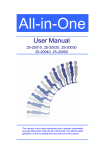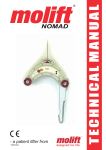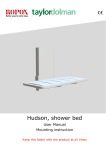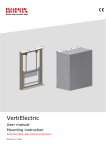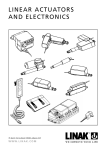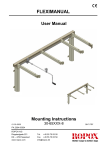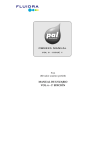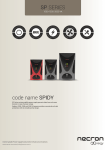Download Ropox User Manual All-In-One - Medical Equipment & Services
Transcript
All-in-One Hoist User Manual 25-20010, 25-20020, 25-20030 25-20040, 25-20050 PDF 5946 Nov-2010 General about the hoist Index General about the hoist Operation Operating instructions Battery charging Safety function, lifting motor Emergency stop Emergency lowering Brakes Transfer - person lifting General Lifting to and from wheelchair Lifting to and from bed Lifting from floor Transfer – Stand-up hoist General Lifting from chair Assembly instructions 25-20010, 25-20020, 25-20030 25-20040, 25-20050 Technical information Maintenance Daily check Cleaning Monthly maintenance Yearly inspection Trouble shooting Claims deadline and service 3 4 4 5 5 5 5 6 6 7 7 8 8 9 10 11 14 14 14 14 15 16 In case of inquiries concerning spare parts and service, please state the following information: Customer: Hoist model: Serial number: Year and month: Max. load: Producer Ropox A/S Ringstedgade 221 DK-4700 Næstved Tel.: +45 55 75 05 00 Fax: +45 55 75 05 50 [email protected] www.ropox.dk 2 Distributor General about the hoist Note! It is important that the user is familiar with the operation of the hoist and its facilities and that the hoist performs properly. In order to obtain optimum safety, all persons operating the hoist must read these instructions carefully prior to use. All-in-One lifts have a life expectancy of 10 years, subject to the electronics and moving parts that depend on the daily use and maintenance according to this manual. Ropox A/S is only responsible for the safety of the hoist, its reliability and performance subject to the following conditions: · · · · The hoist must be assembled and connected according to our instructions. The hoist must be used and cleaned as described in these instructions. The hoist must be used indoor. The hoist must be inspected at least once a year according to the procedures of the “Service Manual”. The hoists are intended for lifting persons, e.g. from floor, chair and bed. The special leg-spreading facility also makes it possible to lift the person from toilet and bath. NOTE! UNDER NO CIRCUMSTANCES should the hoist be used for lifting objects other than persons – and only persons, whose weight, including the lifting sling, does not exceed the maximum load stated. In the event of loads exceeding the maximum value prescribed or lifting of objects other than persons Ropox A/S shall disclaim any responsibility in connection with insurance, right to complain and service. Users should always make sure that the mechanical and electrical systems of the hoist work satisfactorily. In case of malfunction the hoist must be stopped immediately and inspected or repaired, as required. Malfunction may be a symptom of defects that may get worse and jeopardise the safety in critical situations The battery should be charged at regular intervals to ensure that the hoist is always operational (e.g. every night). Warning! or Note! means that the text contains important safety and operating instructions, which must be observed in order to avoid accidents. The All-in-One hoist has CE-marking and thus meets the functional and safety requirements of the Directives for Medical Devices, Low Voltage and EMC. Declaration of Conformity can be delivered on request. The product is in risk group 1. It has been tested by the Danish Centre for Assistive Technology according to the rules of Standard DS / EN ISO 10535, „Hoists for the transfer of disabled persons – requirements and test methods“. All electrical components meet current electrical standards. 3 Operation Note! It is important to have read this User Manual prior to operation in order to be familiar with the use of the hoist and its facilities. This will ensure optimum safety for all users. For the All-in-One you can use any of Ropox Domino slings Operating instructions 1. Check that the emergency stop has been released. If not, turn the button clockwise until release. 2. The hoist is operated by means of the hand control unit. The two upper buttons control the lifting/lowering movement, whereas the two lower buttons control the leg spreading facility. It is not possible to use two functions simultaneously. Note! In case of erroneous operation of the hand control unit (e.g. too quick change of direction) the hoist does not react. Let go of the push button – wait a few seconds and press again. 3. Check that the sling provided is correct for the lifting operation to be performed. This applies to size as well as shape. Further information about the choice of slings will be found in ”Domino Slings User manual”. 4. The battery should be recharged regularly, to ensure that the hoist is always available (e.g. every night). Emergency situation Emergency stop and emergency lowering (electrical and mechanical) should be used in emergencies only. Should it be necessary to activate the emergency functions, contact the distributor before using the hoist again. Recharging the battery · · · · · · · 4 The battery must be recharged after approx. 60 lifting operations – i.e. at 50% battery capacity. In case of continued use you will hear an acoustic signal. The battery can still be used, but it will affect is recharging capability. We recommend charging as soon as the hoist is not being used for a longer period of time, e.g. every night. The battery cannot be over-charged and it is only ”healthy” for the battery to be recharged often as it increases the battery life. Charging is made directly in the control unit by means of the mains cable provided. Insert the cable into the wall outlet and the control unit, see drawing page 12, and switch on power. The hoist cannot be used when connected to mains voltage. A green light on the control unit indicates connection to mains voltage. A yellow light indicates that the battery is being recharged. When the battery has been fully charged, the yellow light will be out. Full recharging takes 4-5 hours. If charging is made via a wall-mounted charging station (optional) a battery may be constantly charged in the station. The batteries may be easily switched by means of the snap system on top of the battery box. Operation Safety function, liftingmotor The lifting motor is provided with a safety function, splejn, against jamming. If the lifting arm meets with resistance during lowering, the movement of the arm will stop automatically. Thus, a person cannot get jammed between the lifting arm and the bed. WARNING!! Owing to the safety function on the motor the lifting arm and spreader bar may fall freely to the spindle of the motor. Therefore make sure that the lifting arm does not ”hang”, that is has always been pressed down to ensure that it rests on the spindle of the motor before and after all lifting operations. This is important as otherwise an injury may result if the lifting arm ”falls” down. Emergency stop If the hoist is to be stopped owing to an emergency – press the red button on the control unit. When the button has been depressed the electrical functions of the hoist cannot be activated and the battery indicator has been switched off. Emergency lowering If the hoist is to be lowered and the hand control unit does not work, there are two possible solutions: - The electrical emergency lowering of the control unit (marked emergency), see drawing page 12. Press with a ball pencil or the like and the person will be lowered slowly. - The mechanical emergency lowering of the lifting motor. Pull up the red handle, see drawing page 11. Brakes The hoist may be braked on the two large rear wheels. Press down the rear part of the brake with the foot to brake the hoist. Release the brake by pressing the front part of the brake with the foot. Note! Brake Release Never brake the hoist during lifting except when used in stand-up mode. 5 Transfer- person lifting General · It is important that the user is familiar with the hoist and that it works satisfactorily before lifting a person. · It is important to choose the correct type of sling for the lifting operation to be performed. This applies to size as well as shape. Further information about the choice of sling will be found in ”Instructions for the Use of Domino Slings”. · With a person in the hoist always move slowly in order to avoid swaying. · Only use the hoist on surfaces with less than 5° gradient. · Only brake the hoist when it is parked or standing on a sloping surface, e.g. in bathrooms. · Never lift a person higher than necessary. · Be aware of the maximum load of the hoist. Before lifting a client, try the hoist yourself. Risk assessment shall be carried out to ensure that the correct size, type and shape of slings is being used for the patient Lifting from wheelchair · Mount the sling. · Increase the width between the legs of the hoist and move it to the chair. · Place the spreader bar above the person in the chair. · Lower the lifting arm and place the straps of the sling correctly in the hooks of the spreader bar. Make sure that all straps have been fitted correctly. · Lift the person a few centimetres above the seat of the chair - STOP – and make sure that the sling has been fitted correctly. · When the person is comfortable in the sling, lift him/her clear of the chair. · Pull the hoist away from the chair - STOP – adjust the legs of the hoist to parallel position before proceeding with the transfer. Placing in wheelchair To place a person in a wheelchair proceed in reverse order: · Increase the width between the legs of the hoist and move it to the chair. · Make sure that the person has been placed correctly in relation to the chair and lower the hoist slowly. · Check that the person is in the proper position during the entire operation. · When assisting a person in getting back into the chair, lower the person to just touch the chair. · If the chair can be tilted a little backward it is easier to place the person correctly. Also pull the straps on the back of the sling. · If two helpers are available, one may press gently on the knees of the person. Note! 6 The wheelchair must be braked during transfer to and from the chair. Transfer – person lifting Lifting to and from bed · If the bed has an adjustable headrest and the client is capable of being raised a little, a raised headrest will facilitate application of the sling. · Place the lower edge of the sling so that it just covers the base of the spine. · If the client is to be transferred from wheelchair to bed, a raised headrest will also facilitate the operation. It will be easier to place the client correctly in the bed and to remove the sling straps. · As an alternative roll the client to a lateral position. Unfold the sling and place it so that the lower edge just covers the base of the spine. · Place the spreader bar above the bed and lower it to approx. 25 cm above the waist. · Fix the straps of the sling in the spreader bar. · Lift the client slowly approx. 2 cm above the bed and make sure that the sling is positioned correctly and that the client is comfortable and properly supported. · Lift the client clear of the bed and transfer him/her to the required position. Note! Always adjust the sling before lifting the client completely clear of the bed. Lifting from floor Make sure that the general condition of the client allows him/her to be lifted. · Follow the same procedures as when lifting from bed when placing the sling under the client. · Lift the client to a half seated position and use a chair or a similar stable back support with a cushion. · Move the open end of the hoist towards the client and lift the legs of the client over one leg of the hoist. Do not brake the hoist. · The hoist may be placed in the opposite position, i.e. with the head of the client towards the control unit of the hoist. · Lower the lifting arm and fix the straps of the sling in the spreader bar. · Lift the client slowly while checking that the sling is placed correctly and that the client is comfortable and properly supported. Note! When operating the hoist use the wheels opposite to the push handles as a pivot point. This will facilitate manoeuvring. 7 Transfer – Stand-up hoist General · It is important that the user is familiar with the operation of the hoist and that it performs properly prior to lifting. · It is important to choose the correct type of sling for the lifting operation to be performed. This applies to size as well as shape. Further information about the choice of slings will be found in ”Instructions for the Use of Domino Slings”. · Transfer of a person in a stand-up hoist must only be made to and from seated position. · The stand-up hoist must be braked during lifting. · The client must not wear slippery clothes or underwear. · Be aware of the maximum load of the hoist. Lifting from chair · Apply the Thorax standing sling with the lower edge right above the waistband. · Increase the width between the legs of the hoist and move it to the chair. · Approach the client and place his/her legs on the base plate. · Push the hoist as closely to the client as possible – brake the hoist. WARNING! MAKE SURE THAT THE FEET OF THE CLIENT DO NOT GET JAMMED BETWEEN BASE PLATE AND FLOOR. · Adjust the knee support so that it provides support right under the knees of the client. · Lower the lifting arm. · Place the lifting straps of the sling in the hooks of the fork-shaped lifting bar. · If the client can hold on to the lifting bar with his/her arms during lifting, use the middle step of the suspension strap. the client has but little stability and strength in the upper part of the body, use the outermost step of the suspension strap. · Tell the client to lean back in the sling and look up. · Now lifting may be commenced. If required, support the client during lifting. · Lift the client to standing position. · If Note! · To 8 We recommend lifting the client approx. ¾, so that the knees are slightly bent. Be aware of the pressure on the knees/lower part of the leg. prevent the sling from sliding upward, place the straps in a loop. Assembly instructions Assembly instructions for All-in-One : 25-20010, 25-20020 and 25-20030 Place the lifting mast in the mast holder of the frame. Tighten the two screws with the 5mm Insex wrench provided. · Connect the cable from the leg spreading motor to the control unit in output terminal 2, see ”Technical information” . · Screws Mounting and dismounting of arm with spreader bar and stand-up hoist module Mounting · · · · · · · Brake the rear wheels. Hold the lifting module (turn it through 90°) so that the locking pin may be pushed into the corresponding slide rail of the lifting mast. Be aware that the bar may swing. We recommend holding on to it. Push in the lifting module. Then turn it 90° clockwise until you hear a click. Make sure that the arm has been properly locked. If the hoist is going to be used as a stand-up hoist, hook on the knee support with base plate. · Now the hoist is ready for use. 9 Assembly instructions Dismounting Brake the rear wheels. If the hoist has been used as a stand-up hoist, lift off the knee support. Pull the locking pin while turning the lifting module 90° counter-clockwise. Be aware that the bar may swing. We recommend holding on to it. Now the lifting module may be pulled out. · · · · · Note! Be aware of the weight of the lifting module. Locking pin Assembly instructions for All in One 25-20040 and 25-20050 Place the lifting mast in the mast holder of the frame. Tighten the two screws with the 5mm Insex wrench provided. · Connect the cable from the leg spreading motor to the control unit in output terminal 2, see ”Technical information” . · Now the hoist is ready for use. 10 Screws Technical information Frame Material: Surface: St.37 Powder-coated in the colours RAL 4006 traficpurple, RAL 4007 purpleviolet and PHM 7812/CWS black. . Wheels Front: Rear: Diameter 75mm double wheels Diameter 100mm with brake Motors Type designation Power consumption, max. Pressure Speed Protection Sound power level (ISO 3746) Lifting motor LA34.4 10A 7500 N unloaded 15 mm/s Loaded 9 mm/s IP66 ≤42dBA Leg spreading motor LA12.1 3.2A 750 N 14 mm/s 6 mm/s IP65 ≤58dBA The lifting motor has a mechanical emergency lowering facility. To release it, pull the red handle. Hand control unit Type designation HB52B The hand control unit has two functions. The two upper buttons control the lifting/lowering movement. The two lower buttons control the leg spreading facility. 11 Technical information Control unit Type designation Mains voltage Output voltage Max. output current Protection CBJ2 100-240V 24V DC 10.8A IP65 The electrical system is intended for periodical use with a duty circle of max. 10%, 1 min. operation / 9 min. pause. 1 2 1. 2. 3. 4. 5. 6. 7. Emergency stop Emergency lowering Charging indicator Connected to mains voltage Plug for remote control Plug for lifting motor, outlet terminal 1 Plug for leg spreading motor, outlet terminal 2 8. Plug for charging, mains cable 3 4 8 5 6 7 The control unit is equipped with: - protective motor switch for lifting and leg spreading, protecting against overloading - short-circuit protection - acoustic signal sounding when the batteries need charging - electrical emergency lowering if the hand control unit does not work - built-in charger Battery Type designation Outlet voltage Protection BAJ1 24V DC, 2.7 amps IP65 The battery is fitted directly on the control unit. When the battery capacity is approx. 50% the control unit will beep during operation, and the battery must be charged. Charging takes 4-5 hours. Note! 12 The hoist does not work during charging. Technical information Dimensions 25-20010 25-20020 25-20040 Person hoist Lifting capacity 150 kg 150 kg Min. lifting height, lifting hook 55 cm 95 cm Max. lifting height. lifting hook 180 cm 191 cm Lifting travel 125 cm 96 cm Length chassis frame 117 cm 117 cm Length legs 97 cm 97 cm Min. inside distance between legs 50 cm 50 cm Max. inside distance between legs 94 cm 94 cm Min. outside distance between legs 65 cm 65 cm Max. outside distance between legs 109 cm 109 cm Height of chassis frame 12 cm 12 cm Free height under legs 7 cm 7 cm 100/75 cm 100/75 cm Turning circle 125 cm 125 cm Weight of arm with spreader bar 6.5 kg Wheel diameter 25-20020 25-20030 25-20050 Stand-up Weight of fork-shaped bar 5.5 kg Weight of knee support with base plate 8.5 kg Weight of battery Total weight Approximate number of lifting operations per charging 3.0 kg 3.,0 kg 51.0 kg 58.5 kg 60 60 13 Technical information 755 600 1980 1225 Dimensions All-in-One 150Kg: 25-20010, 25-20020, 25-20040 590 530 700 840 930 725 410 14 Technical information 520 160 60 115 190 15 Maintenance Always make sure that the mechanical and electrical systems of the hoist operate satisfactorily. In case of malfunction stop the hoist and check or repair it, as required. Malfunction may be a symptom of a defect, which may become worse and present a safety risk in critical situations. It is therefore important to check the hoist as described below. Daily check Sling 1. Check that the slings are clean, If not, send them to the wash. 2. Check for wear and that the seams are intact and not frayed. A worn sling must be replaced. Hoist 3. Check that the hand control unit works satisfactorily and is mounted correctly. 4. Check that cables have been correctly inserted into the control unit. 5. Check visually that shaft and bolted joints run smoothly and silently. 6. Keep the hoist clean. A clean hoist is safer and has a longer life. Cleaning Clean the hoist with a damp cloth wrung in warm water with a mild detergent. Electrical components may be dried with a firmly wrung cloth. Do not use water directly on these components. Never use solvents. Monthly maintenance Sling 1. Inspect the slings carefully and replace them in case of visible defects or wear. Hoist 2. Check that hand control unit, control unit and battery have no visible defects. 3. Check that cables have been inserted correctly and are undamaged. 4. Check that the lifting motor is not bent and is undamaged. 5. Check that all shaft and bolts joints are undamaged and stable. Worn parts should be replaced 6. Check that the wheels run smoothly. Clean them once a month Yearly inspection Preventive service must be made once a year. Follow the procedures described in the ”Service Manual”. 16 Trouble shooting If the hoist does not work, check and test the following procedures before contacting an authorised distributor. 1. Has the battery been charged? 2. Has the emergency stop been released? 3. Have all plugs been inserted correctly? 4. Does the hand control unit work properly and has it been mounted correctly? 5. Try with another hand control unit or charger. 6. If the lifting arm cannot be lowered by means of the hand control unit, use mechanical or electrical emergency lowering, and the lifting arm will come down. Symptom Possible cause Indicator for mains voltage does not light up - Mains voltage not connected - Control unit defective The motors do not start. A click is heard from the relays of the control unit - The plug has not been correctly inserted into the control unit - Motor defective - Control unit defective The motors do not start. No click is heard from the relays of the control unit - Control unit defective - Hand control unit defective Action - Connect mains voltage - Send control unit to repair shop - Insert the motor plug correctly into the control unit - Replace the motor - Replace the control unit - Send control unit to repair shop Send hand control unit to repair shop The control unit is completely dead. No click is heard from the relays of the control unit - Battery completely discharged - Battery defective - Charge the battery - Replace the battery The control unit is in order except for one direction of one channel - Hand control unit defective - Send hand control unit to repair shop - Send control unit to repair shop - Control unit defective 17 Claims deadline and service Claims deadline See General Terms of Sale and Delivery on www.ropox.dk Service Always make sure that the mechanical and electrical systems of the walking trainer operate satisfactorily. In case of malfunction, stop using the product and inspect or repair it, as required. Malfunction may be a symptom of defects that may get worse and jeopardise the safety in critical situations. Preventive service must be carried out once a year, following the procedures of the ”Service Manual”. Service and repairs must always be carried out by trained and competent personnel. We recommend registration in a log book for each walking trainer in connection with service visits to be used as documentation in case of complaints. Only use original spare parts and accessories. Modifications of the walking trainer must be carried out by authorised Ropox personnel. 18 ROPOX A/S Ringstedgade 221 DK – 4700 Naestved Denmark Tel.: +45 55 75 05 00 Fax.: +45 55 75 05 50 E-mail: [email protected] www.ropox.com 19



















